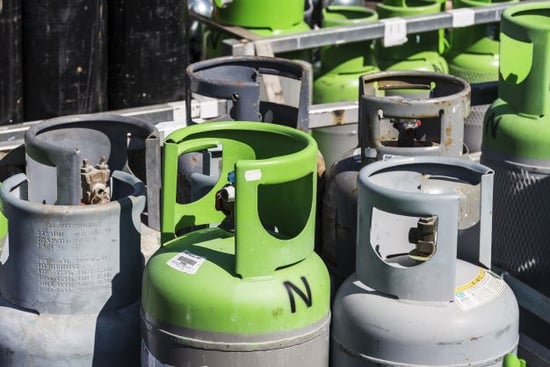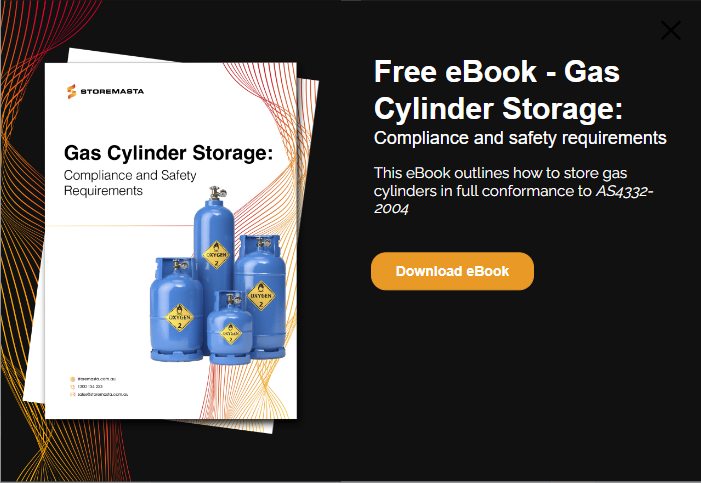One of the most common questions that our Dangerous Goods Storage Consultants get asked is ‘where can you store gas cylinders?’ To answer this query, we’ll be referring to the requirements of the Australian Standard AS 4332 – The storage and handling of gases in cylinders to help you stay safe when working with gases.
Dangers of Gas Cylinders
With every type of hazardous chemical or dangerous good, the requirements for storage and handling are designed to reduce the likelihood and impact of the hazards associated with that substance. When we’re talking about gas cylinders in a work environment, there are many factors that must be considered to reduce the risk of human harm, fire, property damage and more.
While your safety data sheet will explain the exact hazards associated with your gas cylinders (see Section 2: Hazard Identification), there are some general considerations to make when bringing gas cylinders onto site.
These dangers associated with gases in cylinders include:
- Health hazards: pertaining to the type of gas present ie toxic gases or gases which act as asphyxiants.
- Physiochemical hazards: such as fire, explosion or reactions with incompatible substances.
- Physical hazards: including handing injuries or a physical damage caused by airborne cylinders that have suffered damage during storage or handling, or cylinders which have ruptured.
It’s important to remember that, unlike a drum of flammable liquids or a container of corrosive chemicals, the actual metal cylinder poses a threat to safety in a work environment.

There are many hazards associated with gas cylinders including health, physical and physiochemical hazards.
If the cylinder is dropped, knocked over, or suffers damage to the regulator or valve, the compressed gas kept within the metal cylinder will rapidly disperse and potentially cause serious harm as a projectile.
REMEMBER: How you handle and store your gases in cylinders, as well as other types of dangerous goods, can greatly affect the health and safety of your worksite. We recommend creating set procedures and training programs to ensure that all staff, supervisors and contractors ensure best practice when working with compressed gases in cylinders.
Minor Storage of Gas Cylinders in the Workplace
The Australian Standard AS 4332 explains the requirements for the handling and storage of compressed gases in cylinders. If your gas cylinder quantities are classed as ‘minor storage’, then specific sections of the Standard apply – while other sections may not.
Minor storage of compressed gases in cylinders is determined by the quantity of gas you carry as per the specific class. However, it’s important to note that the aggregate quantity of gas must be less than 2,000 litres to be deemed ‘minor storage’.
As per the Australian Standard, minor storage quantities must not exceed:
- 500 L for Class 2.1 Flammable Gases
- 2,000 L for Class 2.2 Non-Toxic Gases
- 1,000 L for Class 2.1 (5.1) Non-Toxic, Oxidising Gases
- 50 L for Clas 2.3 Toxic Gases
IMPORTANT: To learn more about the requirements that apply to minor storage of compressed gases in cylinders, read our popular post Storing Gas Cylinders Safely: Minor Storage Requirements.
Gas Storage Conditions
If your quantities exceed those classed as minor storage, then you must follow the requirements of AS 4332 when storing cylinders in your operations.
Gas cylinders should be stored in gas cages or purpose-built gas stores at your site that effectively control the many risks that the cylinders present.

Compliant LPG cages are specifically constructed for the safe storage of LPG.
The Standard explains just some of the construction requirements for storing gas cylinders:
- Non-combustible materials for the construction of the gas cylinder store. If there are supporting structures, they must also be constructed from non-combustible materials, where practical.
- Level base to ensure stability of gas cylinders. If drainage of the store is necessary, the sloped floor must not compromise stability of stored gases.
- If the store is attached to a building, or located within a premises, it must be separated by one or more walls with a fire-resistance level of 240/240/240.
- When a gas store is located in a multistory premises, the floor above must also be constructed of a material having a fire resistance rating of 180/180/180.
- If there is space between the store and the ground, it must be filled with a solid non-combustible material. Alternatively, it must have at least 2 ends completely open to the air.
- Doors must open outwards or be a ventilated roller door that can be opened from within.
- Gas cylinder stores must be equipped with sufficient ventilation, whether this is natural or mechanical.
- Gas stores must have restraint bars and chains to stop cylinders falling over.
IMPORTANT: We recommend the installation of gas cylinder cages which are designed and constructed in full conformance with AS 4332. Storemasta offers a range of gas cylinder cages and LPG bottle cages, which provide a secure, stable and well-ventilated environment for the storage of your compressed gases.
Other considerations for gas store construction:
- To reduce the risk of gas bottle accidents, bollards and crash barriers need to be installed if gas cylinders are at risk of being impacted by vehicles.
- Ignition sources and heat sources must be excluded from any area where gases are stored.
- Gas stores must be equipped with the correct mandatory signage including dangerous goods diamonds and hazard signs.
- Ensure that the current safety data sheets (SDS) for onsite gases are kept close to gas cylinder stores so staff can reference storage and handling precautions.
- Keep the appropriate personal protective equipment (PPE) in a well-lit, fully accessible location so that staff can put on the equipment before handling the cylinders.
- First aid stations must be provided, with first aid procedures to abide by the information in the safety data sheet.
- Eye wash stations and a safety shower must also be installed, particularly when toxic gases, corrosive gases, cyogenic fluids, or refrigerated fluids are handled.
- Cylinders must be protected against knocks, falling over and impact damage at all times.
- Combustible materials, such as rubbish and vegetation, must be kept away from the gas cage or store by at least 3 metres.
- Stores must be equipped with security measures, such as padlocked gas cage doors doors or perimeter fencing and CCTV, to prohibit unauthorised entry.
REMEMBER: There are many inspection checks and maintenance issues that can assist with gas bottle safety in the workplace. While this post references many of the requirements that are applicable to Australian worksites, there are many more considerations to make when handling and storing gas bottles. If you are unsure of the requirements, we recommend speaking with a professional, such as a Dangerous Goods Consultant, who can help you improve compliance in your business.
Why the Location of your Gas Store Matters
Where should you locate your gas cylinder cage or store?
Due to the many hazards associated with gas cylinders, including asphyxiation, human harm and the potential for gas cylinders to become projectiles, it is always recommended to store your gases in anoutdoor environment in compliant storage.
Consider how and where you install your gas cylinder storage to mitigate the risks posed by your chemicals.
Gas cylinders can’t be stored indoors unless the premises has been designed for this type of gas storage — and is equipped with the appropriate fire rated walls and ventilation.
You should install your gas cylinder cage or gas store in a location that is:
- In a secure area of the workplace.
- Located on a flat, non-combustible base that is well maintained.
- Above ground level.
- Well-lit, so staff can read signage, labels and SDS.
- Not impeding emergency evacuation procedures.
- Segregated from all incompatible dangerous goods and combustible liquid stores by a distance of at least 5 metres.
- Separated from protected places by at least 3 metres.
- Away from any materials which may increase fire risk including trees, refuse and combustible items.
- Properly placarded with the appropriate dangerous goods and hazard signage.
- Protected from sources of heat.
- Not situated in direct sunlight.
- Isolated from ignition sources.
- Free from impact hazards.
- Equipped with all relevant safety measures including first aid, decontamination stations and PPE.
- Capable of containing leaks, spills and the run off of firefighting water.
- Designed to allow for the maintenance of gas storage areas.
- Considered in the emergency planning and fire safety procedures for the workplace.
REMEMBER: There are special considerations for many types of gases, including flammable gases, toxic gases and gases which pose an asphyxiation risk. Refer to the individual safety data sheets of your gas products, in addition to the Australian Standard, to determine the exact storage and handling measures for your compressed gases.
Need Help with Gas Cylinder Cage Locations?
As we’ve highlighted in this blog, gas cylinders must always be protected from unauthorised access, impact damage, radiant heat, ignition sources (flammable gases), incompatible dangerous goods, combustible materials and enclosed areas without sufficient mechanical ventilation.
If you’d like further assistance regarding gas bottle storage in the workplace, reach out to our Dangerous Goods Storage Consultants who can assist with your enquiries. We also invite you to download our free eBook which details the gas cylinder compliance and safety requirements that apply to your workplace.

Living life by the 4 C’s of marketing – communication, coffee, compliance… and more coffee – Leisa Andersen is Storemasta’s Content Marketing Manager. When she’s not writing, you’ll find her enjoying all the good things in life, including shopping, travel and gluten free donuts.

